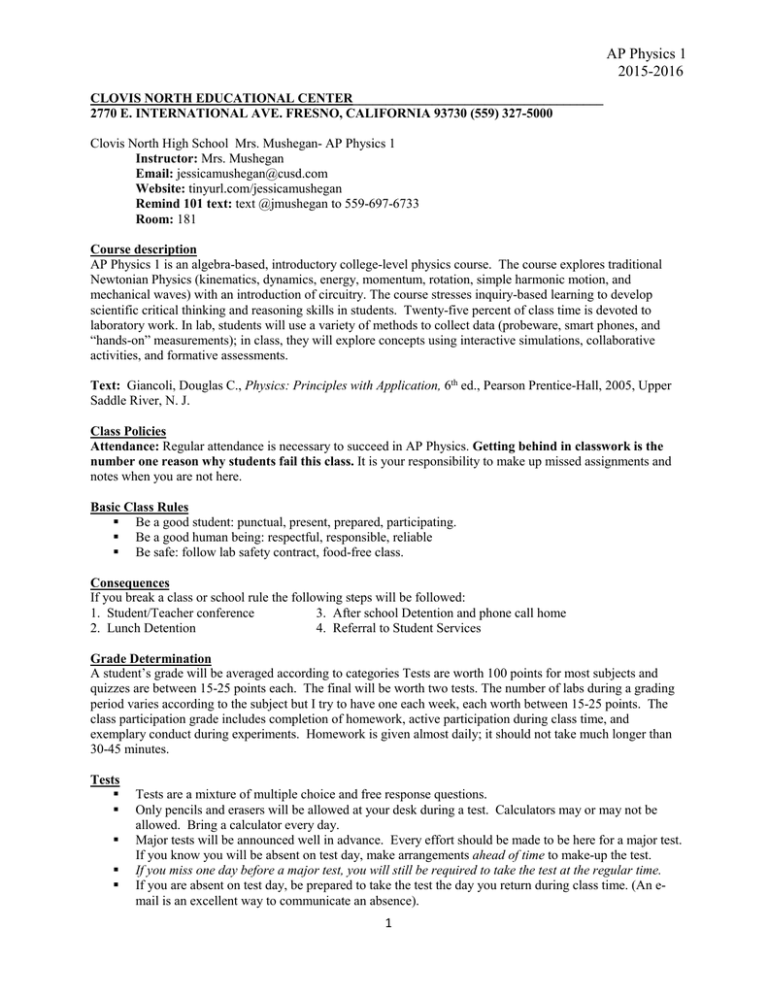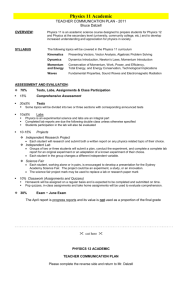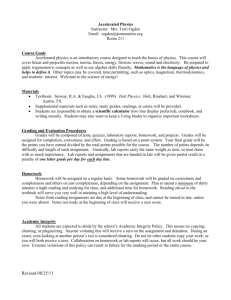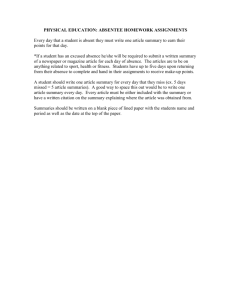
AP Physics 1
2015-2016
CLOVIS NORTH EDUCATIONAL CENTER______________________________________
2770 E. INTERNATIONAL AVE. FRESNO, CALIFORNIA 93730 (559) 327-5000
Clovis North High School Mrs. Mushegan- AP Physics 1
Instructor: Mrs. Mushegan
Email: jessicamushegan@cusd.com
Website: tinyurl.com/jessicamushegan
Remind 101 text: text @jmushegan to 559-697-6733
Room: 181
Course description
AP Physics 1 is an algebra-based, introductory college-level physics course. The course explores traditional
Newtonian Physics (kinematics, dynamics, energy, momentum, rotation, simple harmonic motion, and
mechanical waves) with an introduction of circuitry. The course stresses inquiry-based learning to develop
scientific critical thinking and reasoning skills in students. Twenty-five percent of class time is devoted to
laboratory work. In lab, students will use a variety of methods to collect data (probeware, smart phones, and
“hands-on” measurements); in class, they will explore concepts using interactive simulations, collaborative
activities, and formative assessments.
Text: Giancoli, Douglas C., Physics: Principles with Application, 6th ed., Pearson Prentice-Hall, 2005, Upper
Saddle River, N. J.
Class Policies
Attendance: Regular attendance is necessary to succeed in AP Physics. Getting behind in classwork is the
number one reason why students fail this class. It is your responsibility to make up missed assignments and
notes when you are not here.
Basic Class Rules
Be a good student: punctual, present, prepared, participating.
Be a good human being: respectful, responsible, reliable
Be safe: follow lab safety contract, food-free class.
Consequences
If you break a class or school rule the following steps will be followed:
1. Student/Teacher conference
3. After school Detention and phone call home
2. Lunch Detention
4. Referral to Student Services
Grade Determination
A student’s grade will be averaged according to categories Tests are worth 100 points for most subjects and
quizzes are between 15-25 points each. The final will be worth two tests. The number of labs during a grading
period varies according to the subject but I try to have one each week, each worth between 15-25 points. The
class participation grade includes completion of homework, active participation during class time, and
exemplary conduct during experiments. Homework is given almost daily; it should not take much longer than
30-45 minutes.
Tests
Tests are a mixture of multiple choice and free response questions.
Only pencils and erasers will be allowed at your desk during a test. Calculators may or may not be
allowed. Bring a calculator every day.
Major tests will be announced well in advance. Every effort should be made to be here for a major test.
If you know you will be absent on test day, make arrangements ahead of time to make-up the test.
If you miss one day before a major test, you will still be required to take the test at the regular time.
If you are absent on test day, be prepared to take the test the day you return during class time. (An email is an excellent way to communicate an absence).
1
AP Physics 1
2015-2016
Make-up tests: In cases where you have missed many days, the student has 2 days upon returning to
school to make arrangements with the teacher to make up tests. Make-up tests are at the convenience of
the instructor. Students will lose 10% from the exam grade per day late. It is the student's
responsibility to make arrangements to make up exams. If the absence is unexcused, the student will
earn 50% of his score on the test.
Quizzes
They are composed of short answer questions. Quizzes may or may NOT be announced and will be
administered weekly or biweekly.
Laboratory Work
The AP College Board requires that students keep a lab journal which colleges may ask to review for
AP credit. Therefore, students are required to keep a notebook. Students are expected to follow safety
guidelines at all times.
Every student is required to sign a lab safety agreement. Failure to observe all safety rules during an
experiment will result in expulsion from the lab and a zero for the experiment.
Experimental procedures and calculations are an important aspect of Physics and may be included on
tests.
Students work in groups to collect data but each lab report must be the student’s own work. Copying
answers to lab questions is not allowed. Copying answers will adversely affect the lab grade and the
class participation grade.
Make-up Labs
You must make arrangements for a make-up lab to avoid receiving a zero on the lab. Sometimes it isn’t possible
to make-up a lab. If this is the case, you will be given an assignment in place of the lab or you will write the lab
report using data you get from me, but will earn 1 letter grade lower. Labs are an integral part of this course.
You will need to know the skills and observations from each lab, even when it cannot be made up.
Homework
Homework will be assigned regularly and is due at the beginning of class.
Homework will be graded on completion, i.e., the students has attempted at least 80% of the problems.
Students may collaborate on homework but copying a classmate’s homework is not allowed and is
cheating. Students discovered copying homework will get 0 points for the assignment.
Homework grades are entered on a unit (not weekly) basis.
Grading Policy
A student's grade is calculated by averaging the total points earned from the following categories: class work and
participation 15%, quizzes 15%, labs 20%, unit tests and final 50%. Students will complete all class notes,
homework, and lab work in a spiral bound notebook. Individual assignments will be checked on the day they
are due. Late assignments will receive partial credit if completed before the notebook is due. No late work will
be accepted for credit after a notebook is graded. Grades will be posted in class after each exam. Letter grades
are assigned based on the following:
The grades will be based on the following scale:
A=100-89.5%, B= 89.4-79.5%, C= 79.4-69.5%, D= 69.4-59.5%, F= 59.4%-below
Note that all grades will be rounded to the nearest whole percentage.
2
AP Physics 1
2015-2016
Classwork and Participation
Attendance is essential in the learning process. You cannot expect to succeed if you do not participate in the
daily activities of the classroom. This is a fast moving course. Generally, the ones who participates the most
learn the most. Behaviors that will limit your learning during class time include the following:
1. Not bringing materials (especially calculator) to class.
2. Using cell phones or other electronic devices (besides which they will be confiscated and students will
be referred to students services).
3. Not being ready to work when class starts.
4. Talking when the teacher or another student is speaking.
5. Writing on tables or abusing lab equipment.
6. Not cleaning up your area when you are done (including food and water residue).
7. Not actively participating in-group activities such as labs and white boarding.
8. Work from other classes will not be allowed unless you have finished all of your class work in my
class.
9. Being tardy
Academic Dishonesty
Students are expected to perform their own work on all assignments in this course. Dishonesty on an exam, quiz,
homework, classwork, or lab report will result in a grade of zero for that assignment and an academic dishonesty
report will be filed. School policy dictates that parents, department chair, and administration will be notified, the
student will receive a zero on the assignment, and administrators will enforce other disciplinary action.
Behavior
Students are expected to behave in a mature way that does not detract from the learning environment.
Disrespect of any kind will not be tolerated. Discipline problems will be handled by one or more of the
following ways; teacher-student conference, phone call to parent, detention, teacher-parent conference, and/or
referral to the office.
Lab misbehavior (dangerous lab actions) will adversely affect a student’s class participation grade.
Electronic Device Policy
Any unauthorized electronic device use will adversely affect a student’s grade. All electronic devices (except
calculators) must be in the back of the room during tests. The penalty of a device (on or off) found on a student
during a test will be a zero on the assessment.
Cheating
Students caught cheating and/or assisting others in cheating will result in zeros and referrals for all students
involved. Repeated offenses will result in suspensions.
Homework
AP Physics is a rigorous course that requires practice. Students should expect homework daily. No late
assignments will be accepted.
Labs
Read and study all laboratory activities to familiarize yourself with the purpose and procedures of the
exercise. You must learn and follow all safety rules. ANY SAFETY VIOLATION and/or LACK OF
PREPARATION during laboratory activities may result in an "F" grade for the activity without makeup privileges. Hair must be tied back, loose sleeves must be rolled back, and feet and toes must be
fully covered by shoes. No open toed shoes are allowed during lab days.
Extra Credit
Students will not need extra credit assignments if they do the required work for the class.
3
AP Physics 1
2015-2016
Extra credit assignments WILL NOT be given to students who are failing due to missing assignments,
late assignment, poor participation, poor attendance, or poor work ethic, and as a result, poor
performance in class.
Extra credit assignments MAY be given as deemed necessary to enhance lessons, or to help deepen the
learning for students.
Extra Help
There will be a time in the school year where you have questions and need help. I am more than happy to
provide help with assignments, assessment preparation or to clarify any material. My office hours are Mondays
and Wednesdays during lunch. The more effort you put into the homework and classwork the better you will do.
I look forward to an exciting year with you!
The content for the course is based on six big ideas:
1. Objects and systems have properties such as mass and charge. Systems may have internal structure.
2. Fields existing in space can be used to explain interactions.
3. The interactions of an object with other objects can be described by forces.
4. Interactions between systems can result in changes in those systems.
5. Changes that occur as a result of interactions are constrained by conservation laws.
6. Waves can transfer energy and momentum from one location to another without the permanent transfer of
mass and serve as a mathematical model for the description of other phenomena.
The course focuses on seven scientific practices:
1. Use representations and models to communicate scientific phenomena and solve scientific problems;
2. Use mathematics appropriately;
3. Engage in scientific questioning to extend thinking or to guide investigations within the context of the AP
course;
4. Plan and implement data collection strategies in relation to a particular scientific question;
5. Perform data analysis and evaluation of evidence;
6. Work with scientific explanations and theories; and
7. Connect and relate knowledge across various scales, concepts, and representations in and across domains.
Topics Covered
1. Kinematics (4 weeks)
One Dimensional Motion (including graphing position, velocity, and acceleration)
Vectors/Scalars
Two Dimensional Motion
2. Dynamics (4 weeks)
Forces, types and representation (FBD)
Newton’s Laws of Motion
Interacting objects (systems)
3. Universal Law of Gravitation (2 weeks)
Circular Motion – kinematics and dynamics
Kepler’s Laws of Planetary Motion
4. Energy (4 weeks)
Work
Energy
Conservation of Energy
Power
5. Linear Momentum (2 weeks)
Impulse and Momentum
Conservation of Momentum (Elastic and inelastic collisions)
Center of Mass
6. Rotation (4 weeks)
Rotational Kinematics
4
AP Physics 1
2015-2016
Rotational Energy
Torque and Rotational Dynamics
Angular Momentum
Conservation of Angular Momentum
7. Simple Harmonic Motion (2 weeks)
Restoring forces and simple harmonic motion
Simple Pendulums
Mass-Spring Oscillators
8. Mechanical Waves and Sound (2 weeks)
Wave characteristics
Waves on a string
Sound waves
Superposition
Resonance, Beats and the Doppler Effect
9. Electrostatics (1 week)
Electric Charge
Conservation of Electric Charge
Electrostatic Forces, Coulomb’s Law
10. Circuits (2 weeks)
Resistance
Ohm’s Law
Kirchhoff’s Laws
Simple DC Circuits
Laboratory Investigations and the Science Practices
The AP Physics 1 course devotes 25% of class time to laboratory investigations. The laboratory component of
the course allows the students to demonstrate the seven science practices through a variety of investigations in
all of the foundational principles.
The students use guided-inquiry (GI) or open-inquiry (OI) in the design of their lab investigations. Some labs
focus on investigating a physical phenomenon without having expectations of its outcomes. In other
experiments, the student has an expectation of its outcome based on concepts constructed from prior
experiences. In application experiments, the students use acquired physics principles to address practical
problems. Students also investigate topic-related questions that are formulated through student
designed/selected procedures.
All students are expected to keep a lab journal. Students are expected to record their observations, data, and data
analyses. Data analyses include identification of the sources and effects of experimental uncertainty,
calculations, results and conclusions, and suggestions for further refinement of the experiment as appropriate.
Outside the Classroom Lab Experience
In addition to labs, students will be required to do one exercise outside of the laboratory experience. Following
the rotation unit, students will pick one of the following projects:
Students will use a video analysis program (LoggerPro) to analyze the motion of a toy as it moves
(either in a straight line or in a circle). Students will provide the toy and do their own videotaping. They
will then present a description of the analysis both quantitatively and qualitatively, including graphs.
Their presentation will be peer critiqued and/or questioned, and they will answer the questions with
supporting evidence.
Using an accelerometer app for their smart phone (SPARKvue is one), students will analyze
accelerations they experience every day. They can take the data while moving down the hall between
classes, while on the school bus, on an amusement park ride, or anything else they want (within reason
– safety first!). Students will present a description of the motion they experienced (not only
acceleration, but velocity and displacement, too), both quantitatively and quantitatively, including
5
AP Physics 1
2015-2016
graphs. Their presentation will be peer critiqued and/or questioned, and they will answer the questions
with supporting evidence.
Students will take two pictures – one of an object in translational equilibrium, and one of an object in
rotational equilibrium. The objects also must have more than three forces acting on them. They will then
construct free-body diagrams for each object, and determine the magnitude of each force acting on each
object. For the object in rotational equilibrium, students will also find the magnitude of each torque
acting on the object. Students will present their work in class. Their presentation will be peer critiqued
and/or questioned, and they will answer the questions with supporting evidence.
Real World Physics
In order for students to become scientifically literate citizens, students are required to use their knowledge of
physics while looking at a real world problem.
All students will be assigned to several teams, and each team will research sources of energy (solar,
fossil fuels, wind, geothermal, hydroelectric, etc.) and the cost-benefit of each. Student teams will
present findings to the class and debate the merits of their assigned energy source.
In addition, students may pick one of the following assignments to complete.
Students will pick a Hollywood movie and will point out three (or more) instances of bad physics. They
will present this information to the class, describing the inaccuracies both qualitatively and
quantitatively.
Students will research a thrill ride at an amusement park. They will present information to the class on
the safety features of the ride, and why they are in place.
Students will present information to the class on noise pollution, and it’s danger to both human and
animal life. They will also propose solutions to noise pollution problems.
Please cut along the dotted line, sign and date below, and return to school with your student.
--------------------------------------------------------------------------------------------------------------------------------------1. During this course students will be viewing segments of the videos “Apollo 13” and “October Sky.” The
students will evaluate the movies by answering targeted questions based on what they have learned throughout
their science studies. We will also view segments of Myth Busters from Discovery Channel. Feel free to call
with questions or concerns. I ________________________ give permission for my child
__________________________ to watch “Apollo 13” - “October Sky” and “Myth Busters.” I know and
understand the content of the movie and am fully aware of my child’s participation.
Parent Name:____________________________ Student Name:_________________________
Parent Signature: ________________________ Date: ________________
2. I have reviewed the syllabus, grading policies, safety, and program outline with my child. We are both aware
of the policies and consequences. I will work with my child to help him or her succeed in AP Physics.
Signature of Parent or Guardian _________________________________ Date_____________
Student signature ________________________________________________ Date__________
Thanks,
Mrs. Mushegan
6







